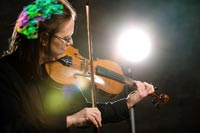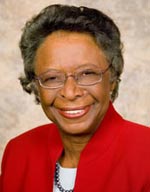Each month, the NSF Current newsletter highlights research and education efforts supported by the National Science Foundation. If you would like to automatically receive notifications by e-mail or RSS when future editions of NSF Current are available, please use the links below:
![]() Subscribe to NSF Current by e-mail |
Subscribe to NSF Current by e-mail | ![]() What is RSS?
What is RSS?

NSF-funded researchers at the University of Florida, Andrew Hanson, Jesse Gregory and graduate student Rocio Diaz de la Garza, have produced tomatoes that contain 25 times more folate than usual, enough to provide an individual's complete daily requirement in just one serving. Folate, also called vitamin B9, is essential for various key metabolic functions, including the production of DNA. The work is described in more detail here.
Folate deficiency, associated with birth defects like spina bifida, is a concern in both developing and developed countries. Ensuring a sufficient source of dietary folate is therefore a top nutritional priority. Many grain products in Western countries are fortified with chemically synthesized folic acid but such fortification is an issue in developing nations because of expense, cultural biases and other issues.
An attractive alternative is biofortification, in which food plants are engineered to overproduce folate. Hanson and Gregory hope to extend their studies to other crops and are continuing work to better understand folate accumulation in plants. Using the model plant, Arabidopsis thaliana, they are dissecting the roles of key enzymes in folate synthesis and degradation. The researchers also study degradation to ensure that accumulated levels are maintained until consumption. This work could allow researchers to find additional avenues for producing more biofortified foods.

A study just published in the European Journal of Neuroscience provides biological evidence that musical training enhances an individual's ability to recognize emotion in sound.
Nina Kraus of Northwestern University has sought to demonstrate just how important music training is in auditory development. Kraus received a two-year NSF grant to examine how musical training influences sensory processes that are necessary for successful communication and learning.
Graduate student Dana Strait, together with Kraus and co-investigators Erika Skoe and Ric Ashley, examined how musicians and non-musicians process sound. Using three acoustic correlates--pitch, timing and timbre--study participants heard a 250 millisecond fragment of a distressed baby's cry while they watched a subtitled nature film. Scalp electrodes measured electrical responses to the sounds in the participants' brainstems, where the auditory nerve connects to the cerebral cortex.
The results showed that the musicians had a heightened response to the complex portion of the sound, where the frequency rapidly changes. However, when the musicians heard the simple sections of the sound, they had lower responses. "Enhanced sensitivity in musicians is not surprising given that musicians must attend to the detailed acoustic properties of sound on a daily basis," said Kraus.
Beyond a natural talent for music, it is really practicing that creates the difference. Musical training fine-tunes the brain to process sound effectively and efficiently. "Engaging in high-level cognitive processes like music enhances your sensory system," said Kraus. To read more, visit the Northwestern University Auditory Neuroscience Laboratory or see the NSF Discovery.

When engineer Krista Marks of Boulder Colorado wanted to develop an online space for school children to learn about basic programming through fun and creative lessons in economics, math, and scientific methods, she founded a small company. Like most people starting small firms she needed funding to turn her dream into reality.
Every federal agency with a large external R&D budget, including NSF, makes a small portion available to small businesses through Small Business Innovation Research (SBIR) grants. Marks applied to NSF and won two SBIR awards totaling $150,000. Her company received the grants to develop its Web site Kerpoof.com and the innovative software that powered it.
The site allows children in grades 3-8 to develop animated cards, stories, drawings or movies, and in the process, learn basic computer programming skills. The company also developed ways for teachers to integrate the Web site into their lesson plans to match educational standards in many topics. The site won the Children's Technology Review's Editor's Choice Award for Excellence in Design in 2008 and again in 2009. All of this activity caught the eye of a major children's entertainment company, which recently acquired Kerpoof and has integrated Kerpoof's technology into its own Web site. The company has continued to maintain Kerpoof.com, and the site is still available to children, parents, and teachers.

Mother's Day is an excellent time to reflect on the deep impact a mother's love and encouragement can have on a child's life. That was definitely the case for Liana Epstein, an NSF Graduate Research Fellow in social psychology at UCLA. Liana says that her mother, Susan Epstein, was "the driving force in my enjoyment of, excitement about, and involvement in science since I was a little kid."
Susan, a professor of computer science at Hunter College whose research is also supported by NSF, worked hard to share her love of math and science with all four of her children by helping them explore their questions about how things worked. "I think most people have really interesting insights and ideas about science," she says "and that they enjoy talking about it when it touches their world." That support kept Liana interested in science even when the rest of the world was telling her girls aren't supposed to be interested in math and science. "We laughed about that a lot and just kept going," Susan says.
Although they work in different fields, Liana feels a connection with her mom's research. "My research may be a little different from my mom's," she says, "but at the end of the day, we're both interested in what makes people tick. That interest was definitely sparked by my mom's work."

An ambitious project to explore the origin, structure and evolution of tornadoes will take place May 10-June 13, 2009 across the central United States. The project, Verification Of Rotation in Tornadoes EXperiment 2, or VORTEX2, is the largest attempt in history to study tornadoes, and will involve more than 50 scientists and 40 research vehicles, including 10 mobile radar units.
VORTEX2 is funded by both NSF, which has contributed $9.1 million to the project, and the National Oceanic and Atmospheric Administration (NOAA), and involves scientists from NOAA, 10 universities and three non-profit organizations. Areas of focus include southern South Dakota, western Iowa, eastern Colorado, Nebraska, Kansas, the Texas panhandle and western Oklahoma. Read more about the VORTEX2 project here.

Credit: Sam Kittner/kittner.com
Cora B. Marrett, Ph.D., serves as the Acting Deputy Director of NSF, a position to which she was named by NSF Director Arden L. Bement, Jr. in January of 2009. As NSF's second-in-command, Marrett has brought to the position a breadth of experience acquired in academia and in public and professional service positions, especially at NSF.
Marrett was NSF's Assistant Director for Education and Human Resources (EHR) from February 2007 through January of this year. While head of EHR, she led the directorate to support the development of a diverse and well-prepared workforce of scientists, technicians, engineers, mathematicians and educators, and a well-informed citizenry that has access to the ideas and tools of science and engineering.
In the mid-1990s, she served as NSF's first Assistant Director for Social, Behavioral and Economic Sciences (SBE). For her leadership in developing new research programs and articulating the scientific projects of this new directorate, Marrett received NSF's Distinguished Service Award.
Marrett is widely published in her field of sociology. Her academic career spans three decades, most spent in the University of Wisconsin (UW) system, where she continues at the University of Wisconsin-Madison as a tenured professor. She has been a member of the faculty for 23 years, with appointments in sociology and Afro-American studies, and additional affiliations with UW programs in energy analysis and policy and land resources. She served as associate chairperson of the Department of Sociology, and most recently, as UW's senior vice president for academic affairs.
Marrett has received multiple distinctions, including the 2008 American Sociological Association's Cox-Johnson-Frazier Award, presented to her for her lifetime of research, teaching and service to the community. The award particularly recognizes her work as an advocate for inclusion in her positions as teacher, researcher and administrator. In addition to her role at NSF, Marrett serves the country in a variety of capacities, including advising two Department of Defense Agencies and serving on the Board of Governors for Argonne National Laboratory. In her new position as NSF's Acting Deputy Director, Marrett will continue to promote the advancement of science and the participation of underrepresented groups in the fields of science and engineering, while pursuing excellence in all that she and the NSF do.
Building a Better Battery (NPR, Science Friday) A team of scientists has found a way to modify the design of lithium-ion batteries so they now charge and discharge in a matter of seconds. Current battery designs take at least six minutes to charge. The work was funded, in part, by NSF.
Engineering Sight (The Columbus Dispatch) A new electronic implant, based on research partially funded by NSF, is allowing people with retinitis pigmentosa, a hereditary disease that robs them of their sight, to regain some vision.
New Research Provides Clues to Malaria Spread (Medical News Today) New research, funded by NSF and NASA, shows a heavy rainfall can decrease the number of malaria cases in wetlands but, counter-intuitively, increase it in dry areas. The explanation, according to researchers, lies in the flatness of the landscape, not in the amount of precipitation, a conclusion that has implications for disease control in a changing climate.
Deep Emissions Cuts Could Lessen Climate Changes (The New York Times) Cutting emissions by 70 percent by the end of the century would cause the Earth to warm by an average of about 2 degrees Celsius, versus 4 degrees if emissions continue growing at their current rate, according to research funded by NSF and the Department of Energy.

A new, breaking news service devoted exclusively to news from the world of science is now available from NSF by email subscription or on the web. The publication, posted daily Monday - Friday, includes breaking news about science topics, a survey of stories recently published in top science journals, recent posts from a wide variety of science blogs, a radio broadcast from Science360's radio feed and live video from NSF's own Studio 8.

Last November, Discover magazine and NSF launched a series of events to explore the biggest questions in science today.
Some of the nation's leading experts in science and engineering gathered to discuss the hottest issues in brain research, address the most compelling topics in astronomy, and focus on the challenges of climate change.
To view a video of the first event, "Unlocking the Secrets and Powers of the Brain," see Discovermagazine.com.
NSF's activities in implementing the American Recovery and Reinvestment Act (ARRA) are updated frequently on our Web site. NSF plans to conduct a webcast in the next few weeks on the special ARRA funding opportunities for NSF's Major Research Instrumentation and Academic Research Infrastructure programs. Watch this Web site for details.

A new exhibit at the Maryland Science Center in Baltimore features artwork, photography and sculpture from NSF's Antarctic Artists and Writers Program. The NSF program makes possible artists' and writers' travel to Antarctica to create writings and works of art to increase public understanding of the region and the research performed there.
The exhibit includes stunning photography, painting and sculpture. One unique feature is a large floor map of Antarctica, created from the latest Landsat satellite data. Footprints in one corner of the room provide a distance scale so visitors can measure their "trek" across Antarctica as they walk across the map.
The exhibit opened April 4 and is scheduled to run through Labor Day. See the Maryland Science Center Web site for more information.

